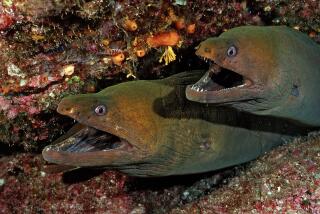On Morro Bay’s 3-Mile Sandspit Trail
- Share via
A walk along Morro Bay’s sandspit offers an opportunity to explore one of the very special environments of California’s central coast. The sandspit trail follows the sand dunes and ridges that separate Morro Bay on the inland side and Estero Bay on the ocean side. Atop some of the higher dunes (about 80 feet above sea level) you will be treated to good vistas of the bay, Morro Rock and nearby mountains.
Heather, salt grass and coyote bush are among the hardy plants surviving in the harsh, wind-lashed environment of the 3-mile-long sandspit. Silvery lupine, sea rocket and evening primrose add some seasonal color.
Bird watchers may spot the snowy plover, which lays its eggs in the sand. On the muddy flats of the spit’s bay side, willets, curlews and sandpipers feed.
Scientists say a very high percentage of all sea life along the central coast originates in Morro Bay Estuary where nutritive-rich waters of different salinities mix, creating an amazingly fertile environment. The triangular-shaped marsh, lined with eel grass and pickleweed, is an important spawning and nursery habitat for such fish as the California halibut and sand perch. Beneath the surface of the bay are oysters, clams, worms, snails, crabs and shrimp.
To learn more about the bay’s ecology, animals and plant life, visit the Morro Bay Museum of Natural History in Morro Bay State Park. Exhibits are well done and the panoramic view of the bay is superb. Information: (805) 772-2694.
A key element in this hike can be the Clam Taxi, or Sand Spit Shuttle, a water-taxi service between the town of Morro Bay and the north end of the sandspit. On weekends the taxi runs every hour on the hour, 9 a.m. to 4 p.m.; weekday service is sporadic. Adult fare is $3 round trip, kids 12 and under ride for $1.50. Information: (805) 772-8085.
Directions to trailhead: Assuming the Clam Taxi is running, this hike begins in the town of Morro Bay at the marina at Pacific Street and Embarcadero.
Another way to reach the sandspit is to rent a canoe from the small marina close to the Museum of Natural History.
If the Clam Taxi isn’t running when you want to hike the sandspit or if you want to begin your hike at the south end of the sandspit, here’s how to reach the south trailhead: From U.S. 101 in San Luis Obispo, exit on Los Osos Valley Road and head west through the town of Los Osos. One block after the road curves left to become Pecho Valley Road, turn right on Woodland Drive. Drive to the end of this road and park.
The hike: From the end of the sandspit, where the Clam Taxi lands, walk south along the bay. The shoreline is silty, salty and quite a contrast to the sandy dunes you’ll be crossing farther south.
Dominating the seascape behind you is the “Gibraltar of the Pacific,” 576-foot-high Morro Rock, first sighted by Juan Cabrillo in 1542. Atop Morro Rock roosts the endangered peregrine falcon, the quickest and most prized of falcons. The falcons are staging a comeback from the devastating effects of DDT, which caused them to lay thin-shelled, fragile eggs. The 50-million-year-old volcanic peak was used as a rock quarry from 1880 to 1969, but is now a wildlife preserve and part of the state park system.
A mile of bayside walking brings you to Houseboat Cove. Across the bay from the cove is Morro Bay Museum of Natural History. A heron rookery is in the cypress and eucalyptus grove near the museum. The herons nest in the treetops between February and June.
Continue another few hundred yards past the cove, then climb over the dunes to the ocean side of the spit. Walk south along surf’s edge, which is littered with clamshells and sand dollars. After about 2 1/2 miles of travel, as the dunes on your left begin to recede, walk up a valley toward the top of the dunes.
You’ll see a large shell mound in the center of the valley, a massive artifact left by the Chumash Indians. They piled clams, cockles, snails and even land game in these kitchen middens. (Inspect this shell mound and the others on the spit with care; they are protected archeological sites.) The bountiful marsh is so full of bird, land and aquatic life that it’s easy to imagine a large settlement of Chumash here--the men hunting rabbits in the dunes, the beautiful baskets of the women overflowing with shellfish.
From the top of the dunes you have a good view of Morro Bay and spit’s end at Shark’s Inlet. Across the bay are the morros, a series of extinct volcanoes that includes the famous Morro Rock. Rising behind the morros are the Santa Lucia Mountains, extending to Big Sur and beyond. This viewpoint is a good place to turn around and return to the trailhead at the north end of the sandspit.
If you have a car waiting at the south trailhead, descend the dunes to a dirt road, which you will follow to a eucalyptus grove and trail’s end at Woodland Drive.
Morro Bay Sandspit Trail
North end to south end: 8 miles round trip.
More to Read
Sign up for The Wild
We’ll help you find the best places to hike, bike and run, as well as the perfect silent spots for meditation and yoga.
You may occasionally receive promotional content from the Los Angeles Times.






